Push-ups, sit-ups, and a strict diet of raisins. That’s my plan.
Jack Black
It took me a long time to understand how to do a push up correctly. Everyone has their opinion of how to teach a push up. To be absolutely honest with you, I actually learned how to correctly perform a push up when I started taking Yoga years ago. I discovered that every time we were told to do a sun salutation, what we were actually doing was the eccentric part of a push up. I would lower my body to the floor, hover for a brief second then push myself to up dog and then down dog. The more I did this, the easier it got. Eventually, all the eccentric work paid off and I found myself able to not only lower my body to the floor correctly, but also push myself back up. When my back started bothering me, I stopped doing Yoga. But I did not stop working on my push ups. In fact, when I started lifting and training more seriously, my push ups became even easier. I was squatting, deadlifting, pressing and benching. My body was getting stronger which meant my “core” was stronger, which meant my push ups were getting better. But isn’t the push up an upper body exercise you would say? Well, yes….and no. It is a full body exercise and, in my opinion, one of the best bodyweight upper body pressing exercises you can do for yourself and your clients if you are a trainer. It definitely separates the men from the women and the women from the girls. And it is all about creating stability in your trunk. Without a stable body, there is no way one can perform a decent push up. The tighter your body, the better your push up. Hands down.
So what to do?? How do you train a push up? For the majority of women out there (and a handful of guys), push ups are just plain hard to do and when they do them, they are downright ugly. And I mean, nasty.

The hips dip, the arms bend at the top, the glutes are loose, the belly is hanging out. Why? No trunk stability. They have not learned to fire the correct muscles in order maintain a good, stable position. When I say fire, I mean abdominals, glutes, shoulders…I told you it was full body!
So, what does a proper pushup look like? Check out the video below. Notice that the trunk is rigid, the elbows are tucked close to the body, the glutes are engaged, the head is in line with the trunk, and the upper arm is parallel with the floor at the bottom of each repetition.
Proper pushup form
It bears emphasizing that the elbows should be tucked close to the trunk, and not flaring out as is commonly seen in most gyms. When you flare your elbows, you put undue strain on your shoulder joint, which is not good in the long run, as you will likely develop shoulder pain. By tucking the elbows, you relieve the pressure on the shoulder joint, and make the exercise more healthy and effective at the same time. Here’s a video of me flaring my elbows badly. Please do NOT do your pushups this way. 🙂
Bad pushups with flared elbows
If you want to read an in depth article about the push up, look no further than Bret Contreras’ article here. It explains very well why people cannot properly execute a push up, the mechanics behind the push up, and the differences between men and women when it comes to the push up. For my purposes, I am giving you the short and sweet version of how we train the push up at Fivex3 Training.
There are a few methods that we employ here. In our group classes, we primarily train the push-up using negatives, the eccentric part of the push-up. In order to perform a negative pushup, start with a front plank, and lower yourself to the floor while keeping your body completely rigid. For our group classes, this is the most effective way to work because we don’t have a lot of room for people to be scattered around doing some of the more involved things described below. Negatives are great because they teach you to control your body while performing the pushup motion. We start training the pushup once our group clients can hold a solid plank for at least 45 seconds to one minute. Up until that point, they do not have sufficient trunk stability to move on to pushups. After all, a pushup is nothing more than a plank with arm flexion and extension. If you cannot hold a proper plank, you will not be able to do a proper pushup.
With the negative push-up, you are not only getting good upper body strength – triceps, chest, shoulders, serratus anterior – but you are training the body to remain rigid and stable, the major component when learning how to do a push-up. Too many people focus all their attention on the arms and expect them to do the work instead of focusing on the bigger picture…the entire body from the shoulders all the way down to the toes. A strong position – trunk tight, glutes engaged, shoulders packed – is the foundation of a good push-up. When most people fail the push-up, it is not because they are weak in the arms; they are weak in their trunk and glutes. Take a look at the following two videos. In the first one, I am performing an eccentric (negative) pushup with bad form. Hips sag, belly sticks forward, shoulder blades wing. It looks awful. In the second, you can see what the exercise should look like when performed correctly.
Bad eccentric pushup
If I have older individuals, such as my mom’s friend Linda who is 73 years old and just started strength training with me this past year or members who are overweight and unable to maintain good form in their planks due to their weight, I will incorporate incline push ups using a barbell on the power rack. The height of the bar determines the level of difficulty and the goal is to lower the bar a little bit each time they work. This way, they can work on their push up position without worrying about injuring themselves on the floor. Of course, this works well with any individual who has difficulty performing a push up but in a group setting, it is harder to use this way as it requires a lot of moving the bar up and down for each person. I rather stick to the negatives with my clients as most of them are between the ages of 20 and 50. Check out the video below to see how to perform this variation.
Pushups with hands elevated on bar
Pushup with assistance from an overhead band
Pushup with short band around the elbows
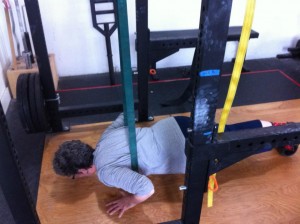
If you are interested in purchasing bands for assistance with the pushup, you can get them from Iron Woody Fitness or Elitefts . These bands are also extremely useful for assisting with the chin-up or pull-up. But that is for another article. 🙂
Good luck, and let us know how you fare!
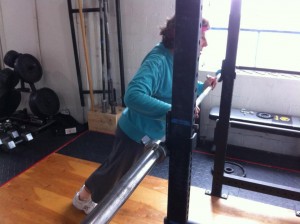
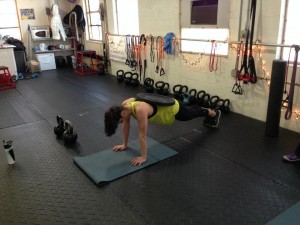
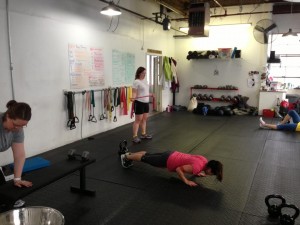
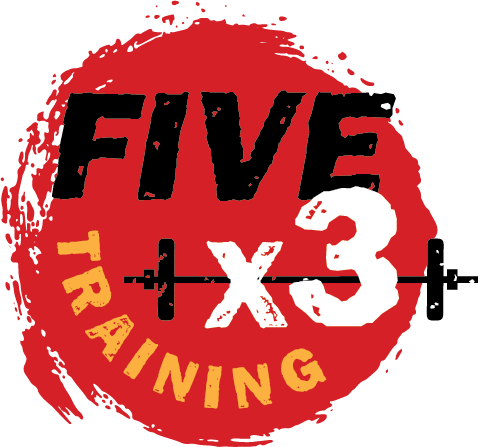
When I was in Army basic training, my greatest fear was that someday the NCO in charge would suddenly bark out, “GIVE ME TEN, JONES!!” in front of the entire platoon. Fortunately, I lucked out, and I never heard the dread command. Why was I so terrified? Well, it would have been more than a little embarrassing for an 18-year 6’2″ 185 pound soldier to be exposed as unable to do push-ups, not even one, in front of his platoon-mates. That’s been the story of my life. I am now 74 years old, and I can’t remember EVER being able to do more than one push-up, and that one was damned difficult. Anyway, since you have obviously spent a great deal of thought and time on this subject, I have to ask if you’ve ever found anyone who was never able to do push-ups despite faithfully following your instructions? Are there some people who just can’t do push-ups?
I might add that I now weigh 211 pounds but have now set my weight goal at 185-190 pounds within the next month. Also, I might mention that I have never been able to do even one pull-up, though I think I’ll be able do so when my weight and my workouts at the gym converge. This should be within one month. Finally, I must add that I appear to be a normal male in every respect, and by “appear” I don’t mean that I have anything to hide. No, I would say that I’m a typical normal, healthy male, but one who can’t do pushups or pull-ups…yet.
Final, final. At my last gym, the maximum bench press I ever achieved was 250 pounds, my maximum shoulder press was 270, with 300 just around the corner, or so I thought, and my maximum pull-down was 270; HOWEVER, I have since learned that many weight-stack machines
LIE. The ones at my last gym certainly did. And it wasn’t only that gym. At the NEW gym where I now go, I can curl–sometimes–180 pounds. However, when I introduce some reality by testing myself with a barbell, the highest weight I have achieved was 75 pounds. Don’t believe what weight-stack machines tell you. They lie. They lie. They lie.
Hi Clifford,
Thanks so much for the email! You know, as of right now, I have not had anyone not be able to do a push up….maybe because I really do follow the progressions that I talk about in my post. 99% of my clients come to me cannot do a push up…men and women alike. The culprit? Weak cores. Upper body weakness, yes…but the problem most people have is they have no control of their trunk – hips, shoulders, abdominals, etc. So we work on planks and planks only. I will do incline push ups with some but this is even a problem especially if they have no idea what a proper plank is. Once they are able to hold a push up position or plank for a solid minute and this is without a lot of shaking, we try negative push ups, just the lowering of the body to the floor, no pushing up. After a few weeks of these, maybe a month or so depending on how often they are training, then we try a push up using band assistance for help, to develop the movement pattern. Do you see how much time it can take to really do a push up? Some pick it up faster; for others, it takes a little longer but it does happen. Developing a strong trunk through heavy lifting – squats, presses, deadlifts – will also help. Barbells don’t lie. Training with weight machines do not teach the body how to properly handle or control weight. Only barbells will do that. Skip the machines. Lift a barbell. That is how to get strong.
The chin ups/pull ups can be coached the same way. Begin with learning how to control your body at the top of the chin up….chin above the bar and hold that position as long as possible. Then lower yourself as slowly as possible. Work on the negative chin up. Use bands if needed to assist you as you begin to drill the movement. It will take time but if you put in the time and the effort, you will achieve that bodyweight chin up or pull up. I think an article about this is something for me to talk about next…..
Thanks for your email! I hope this helps!
Thanks for that. Unfortunately for me, I live on the other end of the county; otherwise, I’d probably sign up. One thing your answer taught me is that not everybody can do pushups and that it’s by no means easy for those who can’t to get to the point where they can. That surprised me. Well, I’ll just have to adjust my expectations. I have a book entitled,”7 weeks to 100 push-ups”. Well, maybe for some, but it didn’t work for me. Now, thanks to you, I know that I don’t have to feel bad about my failure to achieve the promised results. Incidentally, I’m late in replying because I somehow lost my place. That happens too often. I’ll have to be more careful about using bookmarks. Thanks again.
What a great article and Iove the video visuals!
Wish I lived closer and could work out with you.
My pilates teacher has worked with me on push ups and she uses the acronym ABBS (Abs, Butt, Back, Serratus) for the correct muscle firing sequence. We work on top of a bolster doing first head lifts with the back in extension and pelvis neutral. Then into half push ups to the bolster and back. With the Pilates routines we also work a lot of core, but it still takes extra training to get that “head to heel like steel” position while doing a push up. It really is an accomplishment to perform a correct push up. I do wish more trainers paid closer attention to correct form instead of 100s of reps : ) Keep up the quality training!
Thanks Molly!!! Sounds like your Pilates instructor is right on! The push up involves the ENTIRE body, not just the arms. Too many people forget about the back and the glutes. And yes, the serratus plays a huge role. I have my ladies doing push up plus exercises where they just learn to fire the serratus, little movement in the upper body, just enough to feel the back working. So glad you found the article and video helpful! Stop back again!!! 😉
Thank you for sharing such useful content. Best Quotes Website